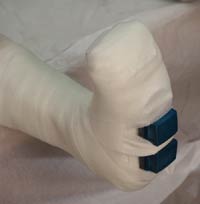a Total Contact Casting Primer with Dr. Michael Miller
(A diatribe in four verses)
Okay fans, let’s talk about the science behind Total Contact Casting. But before we talk about the science, what is a Total Contact Cast? Well, before we talk about Total Contact Casting, let’s talk about the key to not just healing wounds but preventing them. But before we talk about preventing and healing them, we need to talk about them … wounds that is.
Wound is a term that usually means a defect in the epithelium, which is a five syllable word for skin. Another term you might hear is the word “ulcer”. The simplest way to differentiate these two is to remember that an ulcer arises from the inside and comes out whereas a wound starts on the outside and progresses inside. The key to understanding this is by example’s…
The ill equipped robber whose gun fired while he was walking into the store did not receive a gunshot ulcer, he got a gunshot wound. The bullet caused the damage from the outside, in.
The person who took too many aspirin every day and started to have terrible stomach pain did not develop a gastric wound, he developed a gastric ulcer. The lining eroded from the inside out.
The beautiful model who could not have her picture taken had a herpes ulcer of her lip, not herpes wound. This ulcer developed from the inside of her lip to the outside
The patient who had his hernia fixed and then bumped the incision causing it to open, does not have a stomach ulcer, they have a stomach wound. The incision opened up from the outside exposing the inside.
Now that we have the definitions done, back to prevention and treatment. Of course the most obvious question that you need to ask is, what is our diagnosis (diagnoses) for either why this wound developed or what is specifically keeping it from healing?
